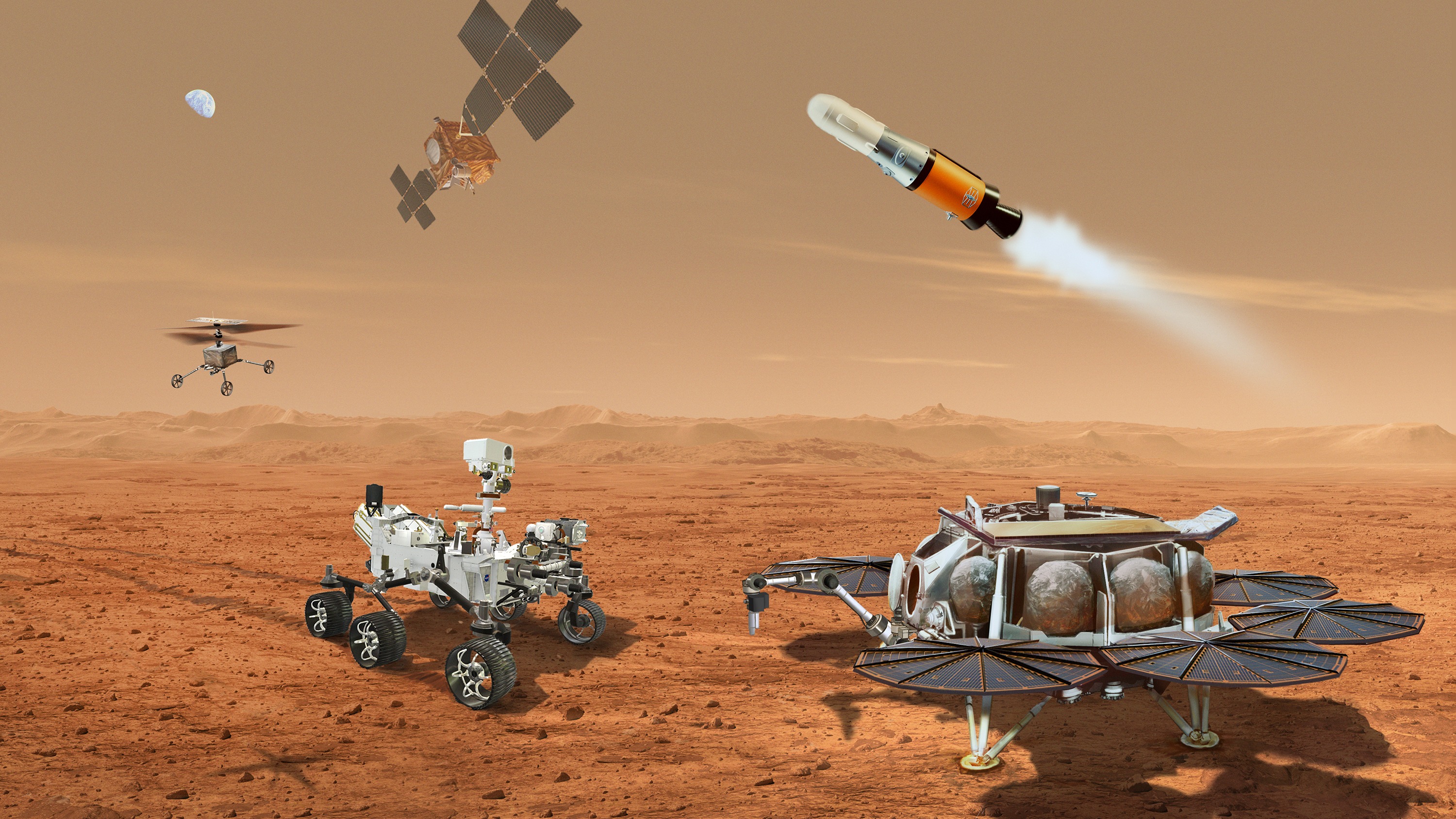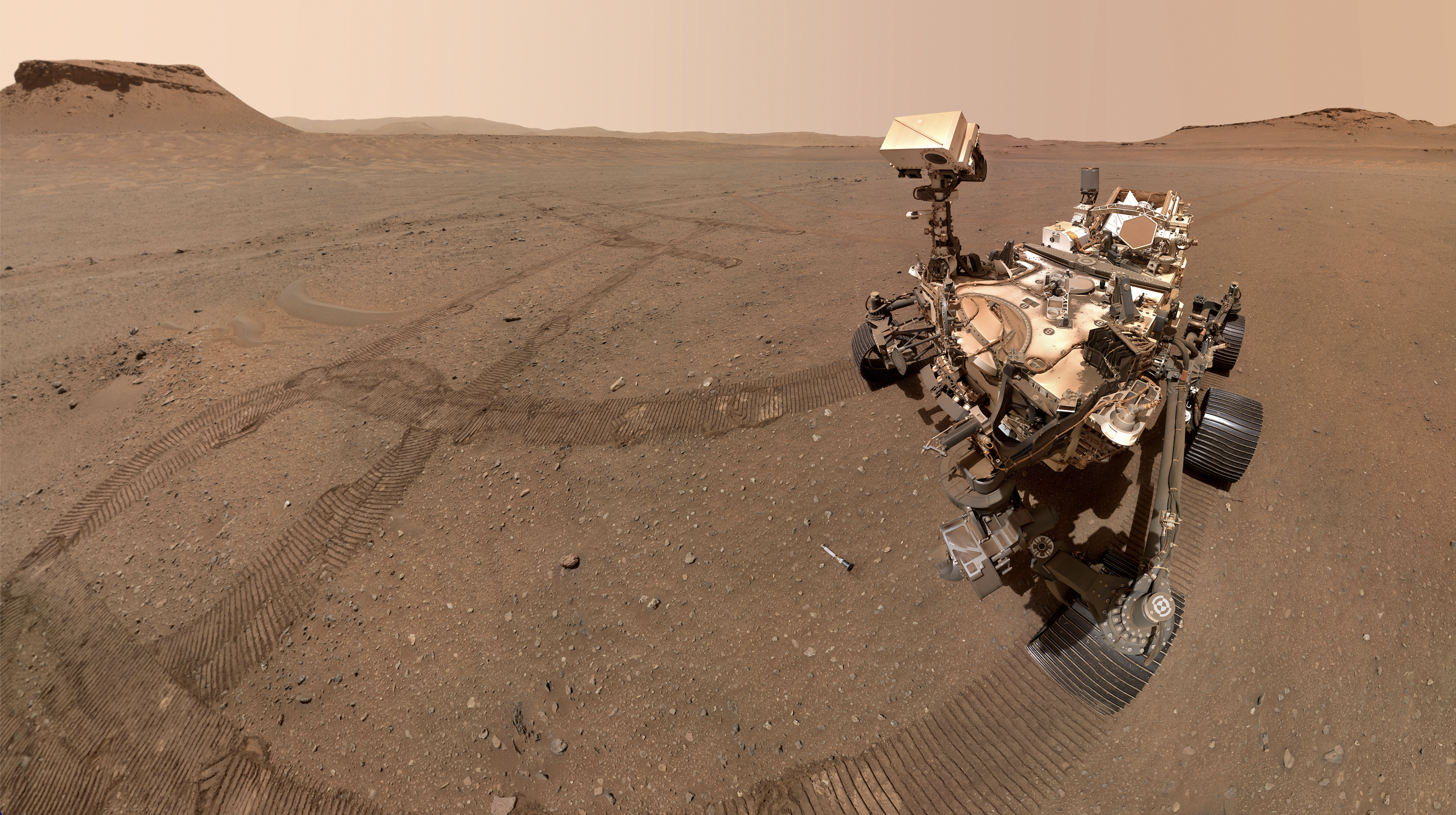
NASA is looking for a new way to get its precious Mars samples back to Earth.
Those samples are being collected by the Perseverance rover in Mars' Jezero Crater, which hosted a lake and a river delta billions of years ago. Getting ahold of the samples is one of NASA's top science goals; studying pristine Red Planet material in well-equipped labs around the world could reveal key insights about Mars — including, perhaps, whether it has ever hosted life, NASA officials say.
The agency has had a Mars sample-return (MSR) architecture in place for some time now, but repeated delays and cost overruns have rendered the original plan impractical, NASA officials announced today (April 15).
"The bottom line is that $11 billion is too expensive, and not returning samples until 2040 is unacceptably too long," NASA chief Bill Nelson said during a call with reporters this afternoon.
Related: NASA's Mars Sample Return in jeopardy after US Senate questions budget
That price tag is the upper-end estimate calculated by an independent review board, which released its findings last September. For perspective: A study from July 2020 estimated the total cost of MSR to be between $2.5 and $3 billion.
A team from within NASA analyzed those September results, determining that the agency won't be able to get Perseverance's samples back to Earth until 2040 with the established architecture. This conclusion cited reasons such as current budget constraints and the desire not to cannibalize other high-priority science efforts, like the Dragonfly drone mission to Saturn's huge moon Titan.
Breaking space news, the latest updates on rocket launches, skywatching events and more!
The established architecture, by the way, would have sent a NASA-built lander to Jezero Crater. This lander would have brought with it a rocket called the Mars Ascent Vehicle (MAV) and, potentially, several small retrieval helicopters akin to NASA's pioneering Ingenuity rotorcraft.
The idea was for Perseverance to drive its samples over to the lander, then load them into the MAV. The retrieval choppers may have done some of this loading work as well, especially if Perseverance wasn't in great shape by the time the lander arrived. The MAV would then have launched the samples into Mars orbit, where a spacecraft built by the European Space Agency would have snagged the container and hauled it back toward Earth.
NASA is now seeking a new way forward, however, in an attempt to cut costs and get the samples here sooner. Saving money will aid other agency science projects, and speeding up the timeline could help the agency plan out crewed Mars trips down the line.
"That is unacceptable, [to] wait that long," Nelson said today. "It's the decade of the 2040s that we're going to be landing astronauts on Mars."

The wheels on the new plan (which may retain elements of the old) are already turning. NASA is asking the Jet Propulsion Laboratory in Southern California — its lead facility for robotic planetary exploration — and other agency research centers for innovative MSR ideas, Nelson said today.
NASA is also looking to private industry: The agency plans to release a solicitation for new ideas from the commercial sector tomorrow (April 16), Nicky Fox, associate administrator of the agency's Science Mission Directorate, said during today's call.
NASA will hold an industry day on April 22 and accept proposals through May 17, she added. The goal is to have enough information on hand by late fall or early winter to begin charting a new path forward on MSR. "We're opening this up to everyone, because we want to get every new and fresh idea that we can," Nelson said.
It's unclear at this point, of course, what that new path will look like. But Fox previewed some possibilities, such as a smaller and cheaper MAV and a descoped sample-return tally (from 30 of Perseverance's sealed tubes to some unspecified lower number). Fox and Nelson both stressed that MSR remains a high priority for NASA, despite the difficulty of the task — humanity has never launched a rocket from the surface of another planet, after all (though three countries have launched from the moon) — in addition to the problems the project has experienced so far.
"I think it's fair to say that we are committed to retrieving the samples that are there — at least some of those samples," Nelson said. "We are operating from the premise that this is an important national objective."
Join our Space Forums to keep talking space on the latest missions, night sky and more! And if you have a news tip, correction or comment, let us know at: community@space.com.

Michael Wall is a Senior Space Writer with Space.com and joined the team in 2010. He primarily covers exoplanets, spaceflight and military space, but has been known to dabble in the space art beat. His book about the search for alien life, "Out There," was published on Nov. 13, 2018. Before becoming a science writer, Michael worked as a herpetologist and wildlife biologist. He has a Ph.D. in evolutionary biology from the University of Sydney, Australia, a bachelor's degree from the University of Arizona, and a graduate certificate in science writing from the University of California, Santa Cruz. To find out what his latest project is, you can follow Michael on Twitter.
-
spike0xff Reply
This was my thought too. Since Elon is spending billions to develop reusable vehicles capable of delivering cargo and humans to the surface of Mars. Could a lightly-loaded Starship return from Mars surface to Earth orbit, assuming fuel was available? Would be ironic if a SpaceX crew did the sample return like "Hey, we found these canisters as we were driving around, so we used our personal luggage allowance to bring 'em home."Mergatroid said:Why not get SpaceX to do it for half of the cost? -
dv8inpp Because Bezos would sue and get paid more for delivering a fraction of capacity and delay the project for a few years .Reply
Boeing would be over budget and years behind schedule -
doofkcans NASA needs to make a simple sample return landing first.Reply
Forget about grabbing caches, just dig nearby & launch with *lots* of telemetry.
This will test out the basics of the return vehicle - almost all first launches of a new rocket have something go amiss.
It would be foolish to place the Perseverance caches at that risk straight off.
A second test might go for the best location Perseverance has previously discovered, land there, quick dig & launch 2nd return rocket.
The caches will still be there waiting once we've got the hang of it. -
vadertime I am going to propose 2 solutions. NASA will need to figure out costs and timeframes for these options.Reply
Option 1:
This will consist of 4 main components, possibly more, but here are the main pieces.
1) a mothership that will transport the lander containing the return vehicle and mini-rover and return to Earth
2) the lander which will house the return vehicle and the mini rover and serve as the launch platform for the return vehicle to the motherhip
3) a mini-rover that will collect the samples from Perseverance and pack them into the return vehicle
4) the return vehicle launches back to the mothership and docks with it where it can a) return with it to Earth or b) transfer the samples to the mothership and then stay behind
Option2:
A fully crewed mission on a large ship that can house multiple astronauts for up to 2 years or more. It will be resupplied from Earth while it orbits around Mars. Landers go down to Mars to retrieve the samples. The samples are analyzed on board the orbital ship, which has laboratories and analysis equipment. The orbital ship is swapped out with a new crew and supplies after 2 years. This becomes a permanent way station in Mars orbit. -
danR Reply
The very return of the samples is mooted by SpaceX's own Mars plans. They will almost certainly have complete recon landers and rovers in multiple locations ~2030, in preparation for boots on the ground, a base, and (possibly) their envisioned colony. Nothing will be returned. The whole shebang will be done in situ: mass spectrometers, microanalytical chem. labs, electron/SEM microscopes.Mergatroid said:Why not get SpaceX to do it for half of the cost?
The sample-return project was a good idea at the time, but those samples are just going to sit there. There's the possibility of contracting to pick them with SX rovers and return them to the Mars labs. But by that time, NASA and SX will likely have contracted to simply do the whole analysis (from that region) afresh. -
Planet Seer How about a slight modification of the fully crewed 2 year model. We need actual space stations that can be crewed indefinitely even for the moon missions. Why not create multiple livable space stations using solar sails that can cruise the distance and deliver both Mars-based labs, upload the most promising of those lab results to the space station for additional research during a mission that would study a wide range of subjects including the Mars samples on the way back towards Earth?Reply
